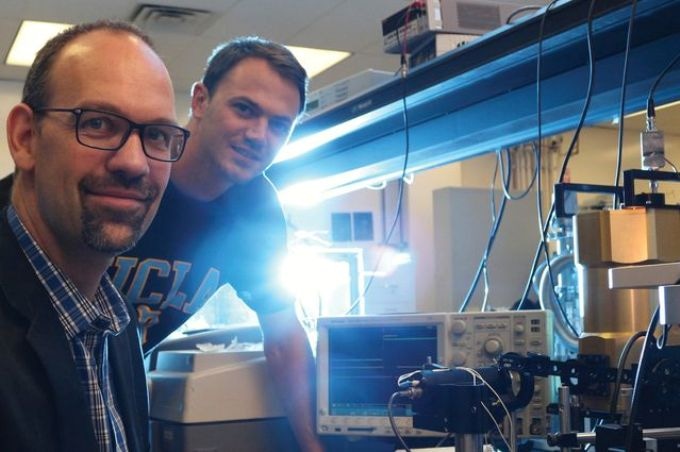Nov 15 2016
 Professor Benjamin Williams, at left, and 2016 Ph.D. graduate Benjamin Burnett at work in the Terahertz Devices and Intersubband Nanostructures Laboratory. (credit: Art Montes de Oca)
Professor Benjamin Williams, at left, and 2016 Ph.D. graduate Benjamin Burnett at work in the Terahertz Devices and Intersubband Nanostructures Laboratory. (credit: Art Montes de Oca)
Invisible to the human eye, terahertz electromagnetic waves are capable of “seeing through” anything, from masonry and wood, to clouds and fog. This feature holds a lot of potential for use in astrophysics research, detecting concealed explosives and several other applications.
Terahertz lasers can generate photons possessing frequencies of trillions of cycles per second - energies between those of infrared and microwave photons. However, these photons are notoriously difficult to generate. This is where UCLA associate professor of electrical engineering Benjamin Williams offers his ideas.
He and his research team at the UCLA Henry Samueli School of Engineering and Applied Science are involved in studying “one of the last frontiers of the electromagnetic spectrum,” as Williams describes it.
Most infrared and optical lasers operate by electrons transitioning between two energy levels in a semiconductor crystal and emitting a photon. However, this method is not so easily applicable to the terahertz range.
If you want to make terahertz radiation, you need a very low-energy photon, so you need two energy levels that are very close together, and that’s hard to do with the semiconductors that nature gives us.
Benjamin Williams, Associate Professor, UCLA
He and his team at the Terahertz Devices and Intersubband Nanostructures Laboratory instead generate terahertz photons by designing artificial materials that imitate the energy levels of atoms.
These so-called “quantum cascade lasers” are developed by positioning various semiconductors in layers - some measuring just a few atoms in thickness - to create quantum wells. Quantum wells can be compared to miniature “boxes” that trap electrons to certain energy levels selected by design.
Photons are released when an electron transitions between different energy levels. A single electron can cascade between the several quantum wells in a quantum cascade laser and activate the release of numerous terahertz photons, generating a strong laser beam. Another benefit of quantum cascade lasers is that the frequency of the emitted photons can be adjusted.
Instead of being limited to the band gap that nature gives you, we can change the width of these quantum wells to choose the effective band gap [and change the photons’ frequency]. That’s a very powerful concept.
Benjamin Williams, Associate Professor, UCLA
Although quantum cascade lasers are strong and tunable in frequency, a major disadvantage has been their poor beam quality.
“Think of a laser pointer, which has a very nice beam,” Williams said. “The beam goes where you want it, and it looks like a nice spot. You’re not wasting the light.”
On the other hand, terahertz lasers frequently have beams that are extremely divergent, meaning that the light beam spans out and becomes weaker as a result. In certain cases, a terahertz laser’s beam diverges a lot so that just 0.1% of it ends up in the area where it was originally intended to go.
A key accomplishment of Williams’ lab has been developing a type of terahertz quantum cascade laser that has both high power and a superior beam pattern.
Our innovation was to make an artificial surface that’s made up of lots of little laser antennas [metal structures that each function like a quantum cascade amplifier]. The net effect is a mirror that reflects terahertz light as it amplifies and focuses it at the same time. We believe that this ability will allow us to create lasers with control of nearly all of the properties of the light—its wavelength, amplitude, phase, and polarization.
Benjamin Williams, Associate Professor, UCLA
The research team is also studying ways to make the quantum cascade lasers to operate at room temperature. At present, scientists have to cool their lasers down to 77 K (-321°F), a step that restricts the use of lasers outside a laboratory.
Currently, Williams is exploring constructing those lasers with the help of quantum dots rather than quantum wells. While quantum wells trap the motion of electrons in only one dimension, quantum dots limit their motion in all three dimensions. The additional confinement in quantum dots is estimated to greatly decrease how much the electrons disperse, which would enable the lasers to operate at room temperature.
“We’re currently working with Diana Huffaker [professor of electrical engineering at UCLA], who grows quantum dots,” said Williams. “[Her work] would allow us to do the same kinds of quantum engineering with quantum dots that we presently do with quantum wells.”
In May last year, Williams was honored by President Obama with a Presidential Early Career Award for Scientists and Engineers, a prize that is awarded to mostly promising young researchers whose achievements encompass both community service and academics. In 2012, he received a National Science Foundation CAREER award and, in 2008, a DARPA Young Faculty Award.
This article was adapted from the original published in UCLA Engineer, the news magazine of the UCLA Henry Samueli School of Engineering and Applied Science.